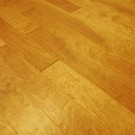What is Tongue and Groove?
Tongue and groove is a style of joining two panels of material together, usually used when installing wood. One side of the panel has a projection called a tongue and the other side has a groove. The panels are laid flat, with each projection fitting into the groove next to it. This system interlocks the panels so that they remain in place, and can be used on floors, walls, siding, ceilings and many other locations.
Tongue and Groove Flooring Advantages
The advantage of the tongue and groove method is that small panels can be combined to create a larger surface. Without the smaller panels, there would be no way to install the large surface all at once.
Additionally, it's a relatively simple, secure way to install paneling, and it looks nice too. With the tongue and groove connecting system, you can start laying panels at one end of the room and continue until you reach the other end. If a standard panel is too large it can be cut to size and moved into position.
When the panels reach the wall, there is usually a small gap between the final panel and the wall. This allows: 1) enough space for the final panel to be installed, and 2) room for the panels to expand and contract with humidity and temperature changes. While the panels can slide back and forth to a slight degree, the movement is negligible and not really noticed. To hide the end gap, decorative moldings are installed at the edges of the wall over the gaps.
DIY vs Professional Tongue and Groove Installation
If you would like to save costs and you have experience, you can opt to install tongue and groove flooring yourself. However, this can be quite an involved and complex process. If you want quality, long-lasting results, it's best to hire a skilled flooring contractor.
Tips
- Nailing. The tongue and groove method keeps your flooring in place by means of pressure applied by the outer panels. However, some experts recommend nailing all or at least a portion of the panels to the surface beneath to add support and secure the floor. This is best done by nailing the tongue of the panel to the surface, at a 45 degree angle towards the rest of the panel, so that the next groove can still fit easily over the tongue.
- Outdoor flooring. While the tongue and groove method can be used for a variety of surfaces and locations, many experts recommend using alternative floors for outdoor areas like decks, especially in rainy areas like Minneapolis. The water and moisture will cause the panels to swell and change shape, so tongue and groove isn't the best choice.
- Painting tongue and groove floors. If you wish to have the tongue and groove panels painted, hire a professional painter, and be sure to paint them before you nail them in. Preferably they should be painted before they are installed altogether, but it's still possible to do it afterward.
Updated June 18, 2018.
Looking for a Pro? Call us (866) 441-6648

Flooring Average Costs
Flooring Contractors Experiences

Hardwood Floor Repair Done Perfectly AND Painlessly

Laminate Flooring Installation In A Sunken Living Room




